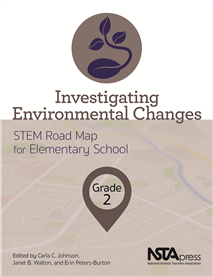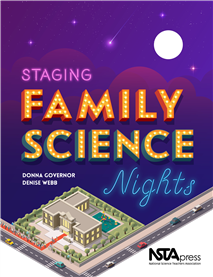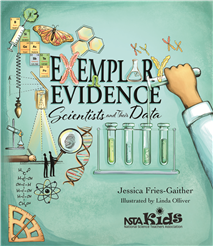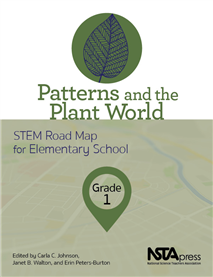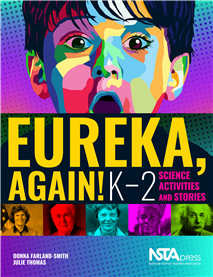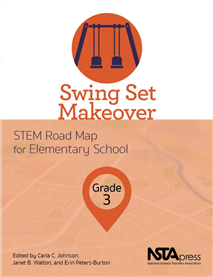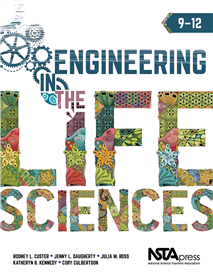All Book Chapters
Book Chapter
Outdoor STEM Classroom Design Challenge
In this lesson, students continue to use the engineering design process (EDP) to create their outdoor STEM classroom. They investigate the phenomenon of seed dispersion and its effects on the environment and use the EDP to construct seed dispersal d...
Book Chapter
Staging Family Science Nights (Book sample chapter)
Get rave reviews for science by putting this book’s step-by-step plans to work. Staging Family Science Nights is your playbook for creating an informal learning environment that will generate enthusiasm and enjoyment of science among the entire fam...
Book Chapter
Exemplary Evidence: Scientists and Their Data (Book Sample)
If you think of science as a puzzle, you’ll see that data is a key to unlocking it. Exemplary Evidence: Scientists and Their Data touches on the world’s many riddles—from how we see to what’s at the bottom of the ocean. It shares how scientis...
Book Chapter
The Beaks of Birds (Book sample)
Come along on a tour of the wonderful world of birds and their beaks. This book is the story of a child and two grown-up friends on a jaunt across their yard, in a park, past a pond, and through the pages of a photo album. Like them, you’ll find yo...
Book Chapter
Patterns and the Plant World, Grade 1: STEM Road Map for Elementary School (Book Sample)
What if you could challenge your first graders to relate changes in seasonal weather patterns to changes in the plant world using a container garden? With this volume in the STEM Road Map Curriculum Series, you can! Patterns and the Plant World ou...
Book Chapter
Scientists and Engineers Are OBSERVANT
In this lesson, students learn that scientists and engineers are observant. They read about Jane Goodall in the book Me … Jane, by Patrick McDonnell. After reading, students observe ghost shrimp and discover patterns of what plants and animals (inc...
Book Chapter
Scientists and Engineers Are IMAGINATIVE
In this lesson, students learn that scientists and engineers are imaginative. They read about Albert Einstein in the book On a Beam of Light: A Story of Albert Einstein, by Jennifer Berne. After reading, students investigate what happens when light s...
Book Chapter
Scientists and Engineers Are EXPLORERS
In this lesson, students learn that scientists and engineers are explorers. They read about Kathy Sullivan in the book To the Stars: The First American Woman to Walk in Space, by Carmella Van Vleet and Kathy Sullivan. After reading, students make obs...
Book Chapter
Scientists and Engineers Are THINKERS
IIn this lesson, students learn that scientists and engineers are thinkers. They read about Alfred Ely Beach in the book The Secret Subway, by Shana Corey. After reading, students will build a model for underground transportation. This book selection...
Book Chapter
Scientists and Engineers Are UNITED
In this lesson, students learn that scientists and engineers are united. They read about the people of the Island of Samsø in the book Energy Island: How One Community Harnessed the Wind and Changed the World, by Allan Drummond. After reading, stude...
Book Chapter
Scientists and Engineers Are ARTISTIC
In this lesson, students learn that scientists and engineers are artistic. They read about Maria Merian in the book Summer Birds: The Butterflies of Maria Merian, by Margarita Engle. After reading, students develop a simple model that mimics the func...
Book Chapter
Scientists and Engineers Are BRAVE
In this lesson, students learn that scientists and engineers are brave. They read about Amelia Earhart in the book I Am Amelia Earhart, by Brad Meltzer. After reading, students will complete a design challenge and build a roller coaster. This book se...
Book Chapter
Scientists and Engineers Are PLAYFUL
In this lesson, students learn that scientists and engineers are playful. They read about Isaac Newton in the book Newton and Me, by Lynne Mayer. After reading, students learn motion words and record the meaning with motions using the Seesaw app. Thi...
Book Chapter
Scientists and Engineers Are EXAMINERS
In this lesson, students learn that scientists and engineers are examiners. They read about Temple Grandin in the book The Girl Who Thought in Pictures: The Story of Dr. Temple Grandin, by Julie Finley Mosca. After reading, students learn to compare ...
Book Chapter
Scientists and Engineers Are DILIGENT
In this lesson, students learn that scientists and engineers are diligent. They read about George Washington Carver in the book A Picture Book of George Washington Carver, by David A. Adler. After reading, students use observations to describe patter...
Book Chapter
Scientists and Engineers Are CURIOUS
In this lesson, students learn that scientists and engineers are curious. They read about Mary Anning in the book The Fossil Girl: Mary Anning’s Dinosaur Discovery, by Catherine Brighton. After reading, students will learn about the history of Eart...
Book Chapter
Scientists and Engineers Are PERSUASIVE
In this lesson, students learn that scientists and engineers are persuasive. They read about Rachel Carson in the book Rachel Carson: Preserving a Sense of Wonder, by Thomas Locker and Joseph Bruchac. After reading, students will collect observations...
Book Chapter
Scientists and Engineers Are FEARLESS
In this lesson, students learn that scientists and engineers are fearless. They read about Eugenie Clark in the book Shark Lady: The True Story of How Eugenie Clark Became the Ocean’s Most Fearless Scientist, by Jess Keating. After reading, student...
Book Chapter
Scientists and Engineers Are PROBLEM SOLVERS
In this lesson, students learn that scientists and engineers are problem solvers. They read about Margaret Hamilton in the book Margaret and the Moon: How Margaret Hamilton Saved the First Lunar Landing, by Dean Robbins. After reading, students will ...
Book Chapter
Scientists and Engineers Are RESILIENT
In this lesson, students learn that scientists and engineers are resilient. They read about Marie Curie in the book Little People, Big Dreams: Marie Curie, by Isabel Sánchez Vegara. After reading, students will plan and conduct an investigation to d...
Book Chapter
Scientists and Engineers Are INSPIRING
In this lesson, students learn that scientists and engineers are inspiring. They read about Thomas Edison in the book Timeless Thomas: How Thomas Edison Changed Our Lives, by Gene Barretta. After reading, students will observe vibrations and provide ...
Book Chapter
Scientists and Engineers Are CATALYSTS
In this lesson, students learn that scientists and engineers are catalysts. They read about Isatou Cessay in the book One Plastic Bag: Isatou Ceesay and the Recycling Women of the Gambia, by Miranda Paul. After reading, students test different types ...
Book Chapter
Scientists and Engineers Are PASSIONATE
In this lesson, students learn that scientists and engineers are passionate. They read about Cynthia Moss in the book A Passion for Elephants: The Real Life Adventure of Field Scientist Cynthia Moss, by Toni Buzzeo. After reading, students observe th...
Book Chapter
Scientists and Engineers Are DEDICATED
In this lesson, students learn that scientists and engineers are dedicated. They read about John Muir in the book John Muir: America’s Naturalist, by Thomas Locker. After reading, students use their seasonal observations about trees to develop a so...
Book Chapter
Scientists and Engineers Are CARING
In this lesson, students learn that scientists and engineers are caring. They read about Helen Martini in the book Mother to Tigers, by George Ella Lyon. After reading, students observe two types of worms and debate whether they are living or nonlivi...
Book Chapter
Scientists and Engineers Are EXPERIMENTERS
In this lesson, students learn that scientists and engineers are experimenters. They read about Michael Faraday in the book Burn: Michael Faraday’s Candle, by Darcy Pattison. After reading, students will use the modified CER framework to discuss ch...
Book Chapter
Scientists and Engineers Are INVENTIVE
In this lesson, students learn that scientists and engineers are inventive. They read about Leonardo da Vinci in the book Neo Leo: The Ageless Ideas of Leonardo da Vinci, by Gene Barretta. After reading, students will plan and conduct an investigatio...
Book Chapter
Scientists and Engineers Are GENEROUS
In this lesson, students learn that scientists and engineers are generous. They read about Katherine Sessions in the book The Tree Lady: The True Story of How One Tree-Loving Woman Changed a City Forever, by H. Joseph Hopkins. After reading, students...
Book Chapter
Scientists and Engineers Are DETERMINED
In this lesson, students learn that scientists and engineers are determined. They read about Elizabeth Blackwell in the book Who Says Women Can’t Be Doctors? The Story of Elizabeth Blackwell, by Tanya Lee Stone. After reading, students learn about ...
Book Chapter
Scientists and Engineers MAKE OBSERVATIONS OVER TIME
In this lesson, students learn that scientists and engineers make observations over time. They read about Ada Twist in the book Ada Twist, Scientist, by Andrea Beaty. After reading, students will recognize that scientists and engineers make observati...
Book Chapter
Scientists and Engineers USE “OUT OF THE BOX” THINKING
In this lesson, students learn that scientists and engineers use “out of the box” thinking. They read the book Not a Box, by Antoinette Portis. After reading, students brainstorm ideas of what to turn boxes into. This book selection highlights th...
Book Chapter
Scientists and Engineers DO EXPERIMENTS TO ANSWER THEIR QUESTIONS
In this lesson, students learn that scientists and engineers do experiments to answer their questions. They read the book Noa the Little Scientist, by Shenell L. T. Bolden. After reading, students perform a simple experiment that is developmentally a...
Book Chapter
Lesson Plan 1: Earth’s Sensational Seasons
In this lesson, students explore the concept of the four seasons and how the changing seasons affect plant development. They will begin to understand that seasonal changes are caused by Earth’s tilt as it rotates around the Sun. Students focus on s...
Book Chapter
Lesson Plan 2: Our Container Garden–Design Time
This lesson introduces students to the engineering design process (EDP), the process they will use to design and create their container garden. In this lesson, students work through the first steps of the EDP to develop a plan for their garden. A mat...
Book Chapter
Lesson Plan 3: Our Container Garden–Planting Time
In this lesson, students continue to use the engineering design process (EDP) to create the class container garden. Students move into the Try phase as they construct the garden. Through the construction and planting of their container garden and sub...
Book Chapter
Lesson Plan 1: Forces Push Back
This lesson introduces students to the module and the culminating challenge of the module, the Swing Set Makeover Design Challenge. A video, discussions, and a trip to the school playground help students connect to the project and excite their curios...
Book Chapter
Lesson Plan 2: Slippery Slide Design
In this lesson, students investigate Newton’s laws of motion and apply their learning to make a more efficient ramp on which a car will travel. This learning activity is directly connected to the final challenge in which students build a model of t...
Book Chapter
Lesson Plan 3: Swinging Pendulums
In this lesson, students continue to explore the forces acting on swing set equipment and the motion that results. Science activities focus on balanced and unbalanced forces as demonstrated by pendulums. Lessons learned from measuring pendulum motion...
Book Chapter
Lesson Plan 4: Swing Set Makeover Design Challenge
This lesson serves as the capstone of the module and challenges students to complete their swing set makeovers. The science and mathematics activities guide student teams through building a model of the proposed designs. Students use the engineering ...
Book Chapter
This lesson asks students to devise a solution to the challenge of a decrease in pollinator availability for crop production. The first goal is to introduce students to justified design, which occurs when design choices for an engineering solution ar...



